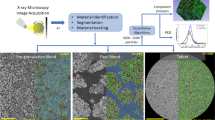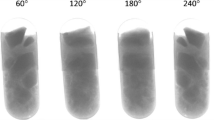Abstract
Automatic segmentation of images, which is now feasible through an increase in available computing power, has become an important challenge in many fields. A key technology for obtaining such images is optical coherence tomography (OCT), which is already widely applied in ophthalmology and more recently in the pharmaceutical industry, as a method for real-time monitoring of solid oral dosage form coating processes. Accurately detecting the boundaries of objects in OCT images is required for a meaningful automatic evaluation. During in-line monitoring, the evaluation time for each image is a crucial factor to enable the real-time analysis of large amounts of data. The segmentation of images has previously been achieved via machine learning methods, which generally require a large number of training examples. This work aims to overcome this limitation by employing unsupervised machine learning for the segmentation of OCT images of coated pharmaceutical tablets. An adapted clustering method was specifically developed to achieve the fast real-time detection of the coating layer’s boundaries in OCT-generated images. A newly developed parallel implementation of DBSCAN, that is well suited for image evaluation, makes it possible to use this novel method for real-time process analytical technology (PAT) applications. This approach has been shown to be significantly faster than so far established methods for segmenting similar OCT images. Furthermore, the image-specific parallelized DBSCAN algorithm has been shown to be around three times faster than other parallel implementations.








Similar content being viewed by others
References
Nixon, M.S., Aguado, A.S.: Image processing. Featur. Extr. Image Process. Comput. Vis. 83–139, 2020 (2020). https://doi.org/10.1016/B978-0-12-814976-8.00003-8
Acharya, T., Ray, A.K.: Image Processing: Principles and Applications. Wiley, Hoboken (2005)
Bishop, C.M.: Pattern Recognition and Machine Learning Chris Bishop. Springer, New York (2004)
Brezinski, M.E.: Optical coherence tomography theory. Opt. Coherence Tomogr. 97–145, 2006 (2006). https://doi.org/10.1016/B978-012133570-0/50007-X
Bezerra, H.G., Costa, M.A., Guagliumi, G., Rollins, A.M., Simon, D.I.: Intracoronary Optical Coherence Tomography: A Comprehensive Review: Clinical And Research Applications. JACC Cardiovasc. Interv. 2(11), 1035–1046 (2009). https://doi.org/10.1016/J.JCIN.2009.06.019
Donaldson, L., Margolin, E.: Visual fields and optical coherence tomography (OCT) in neuro-ophthalmology: structure-function correlation. J. Neurol. Sci. 429, 118064 (2021). https://doi.org/10.1016/J.JNS.2021.118064
Rebolleda, G., et al.: OCT: new perspectives in neuro-ophthalmology. Saudi J. Ophthalmol. 29(1), 9–25 (2015). https://doi.org/10.1016/J.SJOPT.2014.09.016
Markl, D., Wahl, P., Pichler, H., Sacher, S., Khinast, J.G.: Characterization of the coating and tablet core roughness by means of 3D optical coherence tomography. Int. J. Pharm. 536(1), 459–466 (2018). https://doi.org/10.1016/j.ijpharm.2017.12.023
Markl, D., Hannesschläger, G., Sacher, S., Leitner, M., Khinast, J.G., Buchsbaum, A.: Automated pharmaceutical tablet coating layer evaluation of optical coherence tomography images. Meas. Sci. Technol. 26, 3 (2015). https://doi.org/10.1088/0957-0233/26/3/035701
Markl, D., et al.: Calibration-free in-line monitoring of pellet coating processes via optical coherence tomography. Chem. Eng. Sci. 125, 200–208 (2015). https://doi.org/10.1016/J.CES.2014.05.049
Sacher, S., Peter, A., Khinast, J.G.: Feasibility of In-line monitoring of critical coating quality attributes via OCT: thickness, variability, film homogeneity and roughness. Int. J. Pharm. X (2021). https://doi.org/10.1016/j.ijpx.2020.100067
Sacher, S., Wolfgang, M., Peter, A., Stranzinger, S., Khinast, J.: “Real-time monitoring of pharmaceutical coatings by optical coherence tomography (OCT). Manuf. Chem. 96, 34 (2021)
Li, D., et al.: Parallel deep neural networks for endoscopic OCT image segmentation. Biomed. Opt. Express 10(3), 1126 (2019). https://doi.org/10.1364/boe.10.001126
Sappa, L.B., et al.: RetFluidNet: retinal fluid segmentation for SD-OCT images using convolutional neural network. J. Dig. Imaging 34(3), 691–704 (2021). https://doi.org/10.1007/s10278-021-00459-w
Varga, L., et al.: Automatic segmentation of hyperreflective foci in OCT images. Comput. Methods Program. Biomed. 178, 91–103 (2019). https://doi.org/10.1016/J.CMPB.2019.06.019
Wu, M., et al.: Geographic atrophy segmentation in SD-OCT images using synthesized fundus autofluorescence imaging. Comput. Methods Program. Biomed. 182, 105101 (2019). https://doi.org/10.1016/J.CMPB.2019.105101
Koresh, H.J.D., Chacko, S., Periyanayagi, M.: A modified capsule network algorithm for oct corneal image segmentation. Pattern Recognit. Lett. 143, 104–112 (2021). https://doi.org/10.1016/J.PATREC.2021.01.005
Wolfgang, M., Weißensteiner, M., Clarke, P., Hsiao, W.K., Khinast, J.G.: Deep convolutional neural networks: Outperforming established algorithms in the evaluation of industrial optical coherence tomography (OCT) images of pharmaceutical coatings. Int. J. Pharm. X (2020). https://doi.org/10.1016/j.ijpx.2020.100058
Bhalerao, A., Wilson, R.: Unsupervised image segmentation combining region and boundary estimation. Image Vis. Comput. 19(6), 353–368 (2001). https://doi.org/10.1016/S0262-8856(00)00084-6
Liu, X., et al.: Semi-supervised automatic segmentation of layer and fluid region in retinal optical coherence tomography images using adversarial learning. IEEE Access 2019, 7 (2019). https://doi.org/10.1109/ACCESS.2018.2889321
Wu, X., Bi, L., Fulham, M., Feng, D.D., Zhou, L., Kim, J.: Unsupervised brain tumor segmentation using a symmetric-driven adversarial network. Neurocomputing 455, 242–254 (2021). https://doi.org/10.1016/J.NEUCOM.2021.05.073
Baur, C., Denner, S., Wiestler, B., Navab, N., Albarqouni, S.: Autoencoders for unsupervised anomaly segmentation in brain MR images: a comparative study. Med. Image Anal. 69, 101952 (2021). https://doi.org/10.1016/J.MEDIA.2020.101952
Mvoulana, A., Kachouri, R., Akil, M.: Fully automated method for glaucoma screening using robust optic nerve head detection and unsupervised segmentation based cup-to-disc ratio computation in retinal fundus images. Comput. Med. Imaging Graph. 77, 101643 (2019). https://doi.org/10.1016/J.COMPMEDIMAG.2019.101643
Zhang, H., Essa, E., Xie, X.: Automatic vessel lumen segmentation in optical coherence tomography (OCT) images. Appl. Soft Comput. 88, 106042 (2020). https://doi.org/10.1016/J.ASOC.2019.106042
Garcia-Marin, Y., Skrok, M., Siedlecki, D., Vincent, S.J., Collins, M.J., Alonso-Caneiro, D.: Segmentation of anterior segment boundaries in swept source OCT images. Biocybern. Biomed. Eng. 41(3), 903–915 (2021). https://doi.org/10.1016/J.BBE.2021.06.002
Gueziri, H.E., McGuffin, M.J., Laporte, C.: A generalized graph reduction framework for interactive segmentation of large images. Comput. Vis. Image Underst. 150, 44–57 (2016). https://doi.org/10.1016/J.CVIU.2016.05.009
Tian, K., Li, J., Zeng, J., Evans, A., Zhang, L.: Segmentation of tomato leaf images based on adaptive clustering number of K-means algorithm. Comput. Electron. Agric. 165, 104962 (2019). https://doi.org/10.1016/J.COMPAG.2019.104962
Singh, P., Bose, S.S.: A quantum-clustering optimization method for COVID-19 CT scan image segmentation. Expert Syst. Appl. 185, 115637 (2021). https://doi.org/10.1016/J.ESWA.2021.115637
Wolfgang, M., Peter, A., Wahl, P., Markl, D., Zeitler, J.A., Khinast, J.G.: At-line validation of optical coherence tomography as in-line/at-line coating thickness measurement method. Int. J. Pharm. 572, 118766 (2019). https://doi.org/10.1016/J.IJPHARM.2019.118766
Ester, M., Kriegel, H.-P., Sander, J., Xu, X.: A density-based algorithm for discovering clusters in large spatial databases with noise. KDD 96, 226–231 (1996)
Maronna, R., Aggarwal, C.C., Reddy, C.K. (eds.): Data clustering: algorithms and applications. In: Stat. Pap. (2016). https://doi.org/10.1007/s00362-015-0661-7
Muscat, J.: Functional Analysis: An Introduction to Metric Spaces, Hilbert Spaces, and Banach Algebras. Springer, Berlin (2014)
Dice, L.R.: Measures of the amount of ecologic association between species. Ecology 26, 3 (1945). https://doi.org/10.2307/1932409
Pedregosa, F., Weiss, R., Brucher, M.: Scikit-learn: machine learning in Python. J. Mach. Learn. Res. 12, 2825–2830 (2011)
Harris, C.R., et al.: Array programming with NumPy. Nature 585, 357 (2020). https://doi.org/10.1038/s41586-020-2649-2
Wang, Y., Gu, Y., Shun, Y.: Theoretically-Efficient and Practical Parallel DBSCAN (2020). https://doi.org/10.1145/3318464.3380582
Rowe, R.C.: Surface roughness measurements on both uncoated and film-coated tablets. J. Pharm. Pharmacol. (1979). https://doi.org/10.1111/j.2042-7158.1979.tb13557.x
Acknowledgements
The COMET Center Research Center Pharmaceutical Engineering (RCPE) is funded within the framework of COMET—Competence Centers for Excellent Technologies by BMK, BMDW, Land Steiermark and SFG. The COMET program is managed by the FFG.
Author information
Authors and Affiliations
Corresponding author
Additional information
Publisher's Note
Springer Nature remains neutral with regard to jurisdictional claims in published maps and institutional affiliations.
Rights and permissions
About this article
Cite this article
Fink, E., Clarke, P., Spoerk, M. et al. Unsupervised real-time evaluation of optical coherence tomography (OCT) images of solid oral dosage forms. J Real-Time Image Proc 19, 881–892 (2022). https://doi.org/10.1007/s11554-022-01229-9
Received:
Accepted:
Published:
Issue Date:
DOI: https://doi.org/10.1007/s11554-022-01229-9




